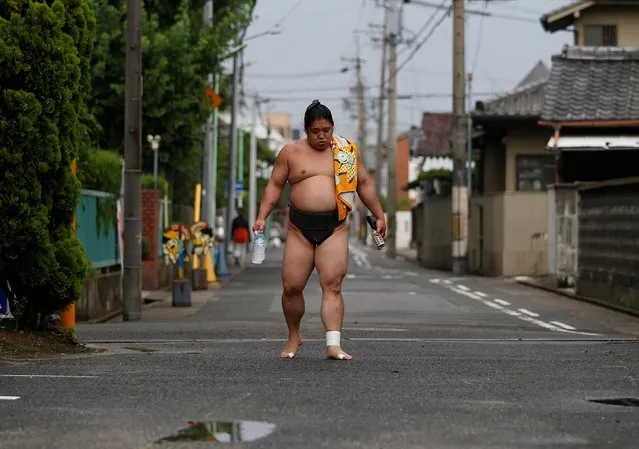
Sumo wrestler Kainishiki returns to training at Ganjoji Yakushido temple in Nagoya, Japan on July 18, 2017. Full assimilation into Japanese culture means that foreign wrestlers face no ill-will. “We wear our topknots, kimonos and sandals, and live by Japanese rules, and the rules of sumo”, said Tomozuna Oyakata. “It's only by chance that we were born a different nationality”. (Photo by Issei Kato/Reuters)
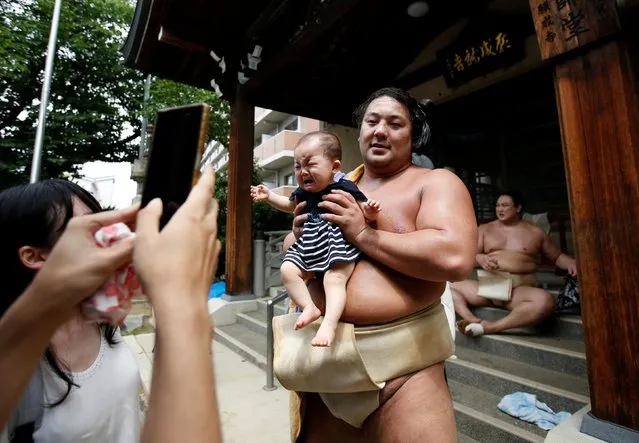
Sumo wrestler Kyokutaisei poses for a photograph with a baby after their training session in Nagoya, Japan on July 18, 2017. (Photo by Issei Kato/Reuters)
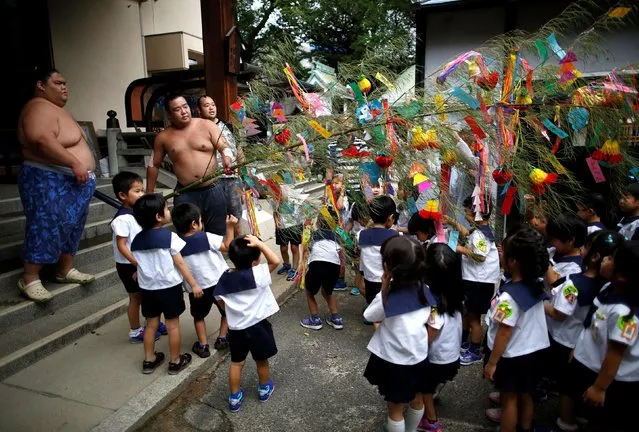
Tanabata festival decorations, made with a bamboo branch and strips of coloured paper, often with people's wishes written on them, are presented to sumo wrestlers from kindergarteners in Nagoya, Japan on July 18, 2017. (Photo by Issei Kato/Reuters)
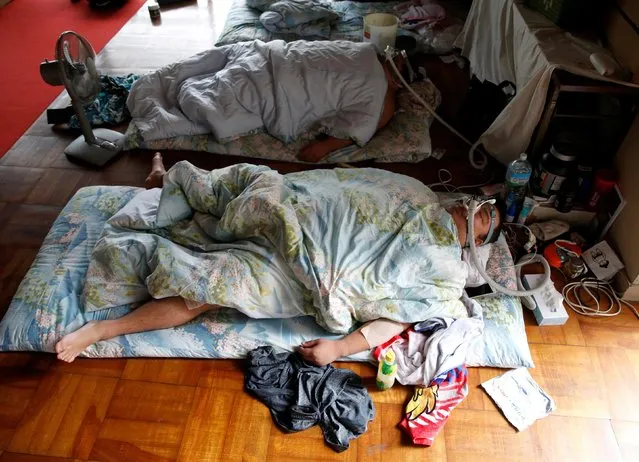
Sumo wrestlers take a nap using masks. To maintain their heft, the wrestlers nap for several hours immediately after eating, wearing masks to aid breathing in Nagoya, Japan on July 18, 2017. (Photo by Issei Kato/Reuters)
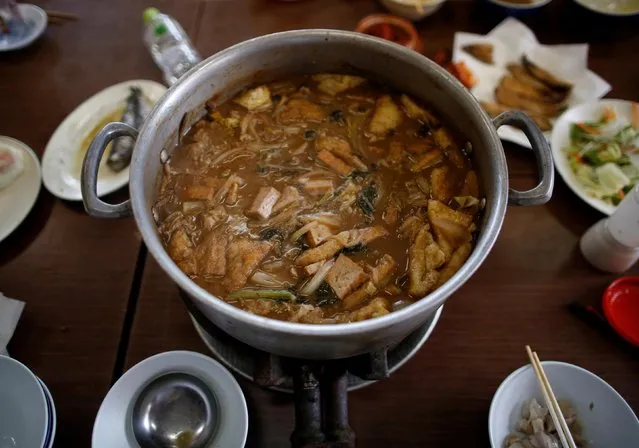
“Chanko nabe”, a signature hot-pot dish associated with sumo wrestlers in Nagoya, Japan on July 18, 2017. Lunch, prepared by the junior wrestlers, is a spread of pig's feet, grilled and deep-fried sardines, steamed rice, and “chanko nabe” – a signature hot-pot dish associated with sumo wrestlers, who are said to consume 8,000 calories a day. (Photo by Issei Kato/Reuters)
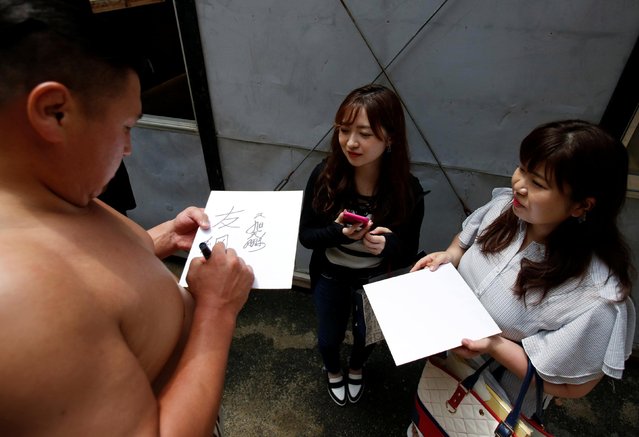
Tomozuna Oyakata signs autographs for fans after a training session in Nagoya, Japan on July 18, 2017. Today, the one-time champion, who was born Nyamjavyn Tsevegnyam, speaks near-flawless Japanese, has a Japanese wife, and has given up his Mongolian nationality to become Japanese – a requirement to become a sumo master, or “oyakata”. (Photo by Issei Kato/Reuters)
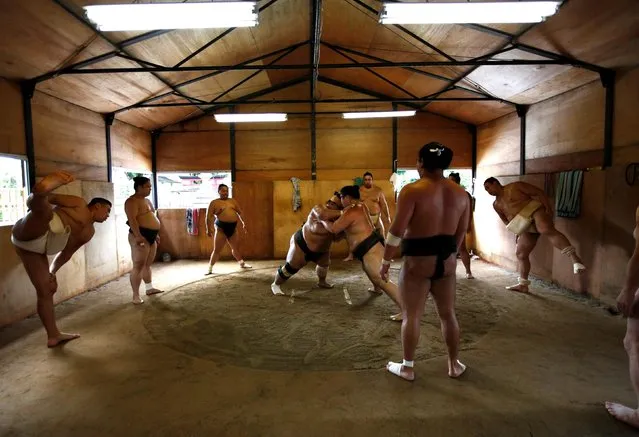
Mongolian-born Tomozuna Oyakata, or master of the Tomozuna stable (L), attends his wrestlers' training session in Nagoya, Japan on July 18, 2017. The wrestlers, or “rikishi”, at the prestigious Tomozuna stable spend more than three hours each morning practising holds in Japan's 15-century-old national sport, with defeat facing the first to fall or be forced out of the ring. (Photo by Issei Kato/Reuters)
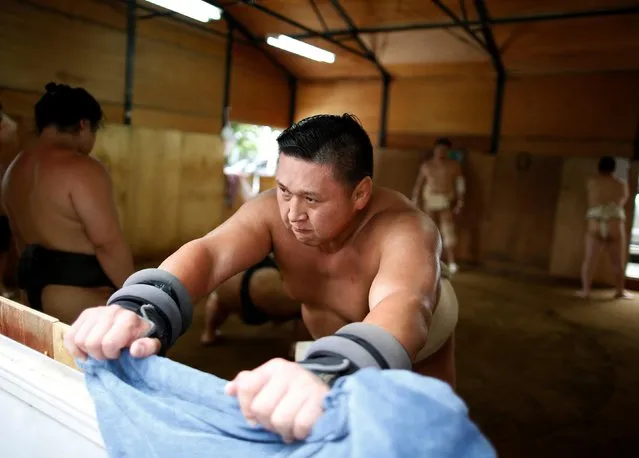
Mongolian-born Tomozuna Oyakata attends his wrestlers' training session in Nagoya, Japan on July 18, 2017. But the tough training and tradition-bound ways have put off many local youth from the sport, leaving sumo to be dominated by foreign – mainly Mongolian – wrestlers, who face a gruelling path to assimilation. “Language was the biggest source of stress”, said Tomozuna Oyakata, better known by his fighting name Kyokutenho, the first Mongolian-born wrestler to lead a sumo stable. “I couldn't understand anything when I was being scolded, or even when I was being praised”, said the master, one of the first six Mongolians to be inducted into the sport in 1992. (Photo by Issei Kato/Reuters)
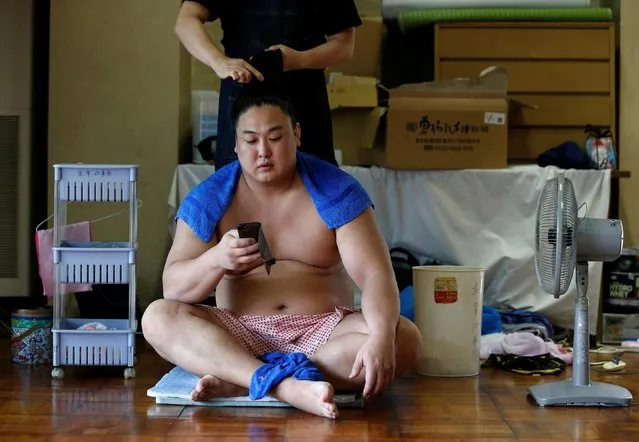
Mongolian-born sumo wrestler Kyokushuho has his hair fixed after a training session in Nagoya, Japan on July 18, 2017. (Photo by Issei Kato/Reuters)
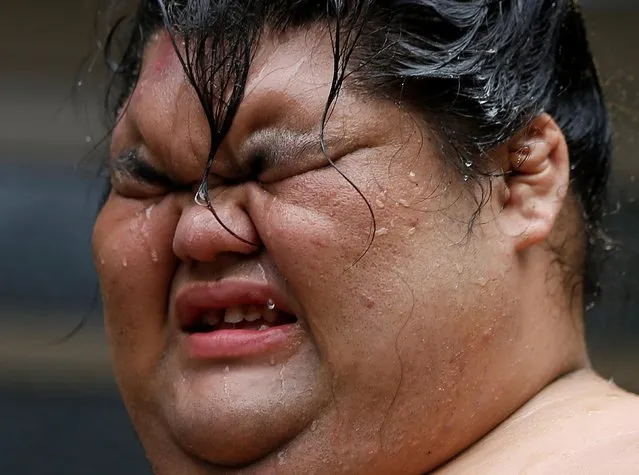
Sumo wrestler Kaiho reacts during a training session in Nagoya, Japan on July 18, 2017. (Photo by Issei Kato/Reuters)
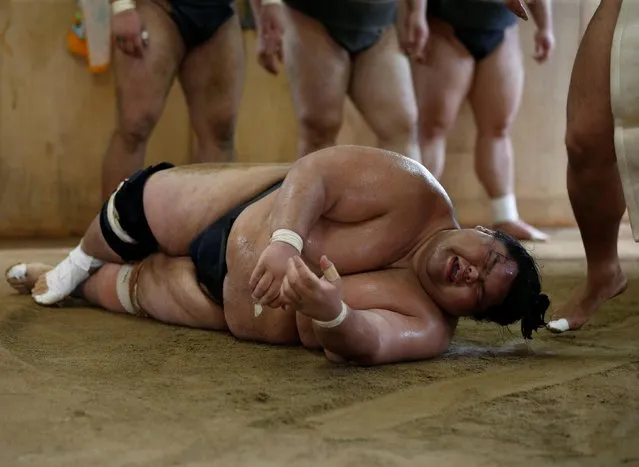
Sumo wrestler Kaiho takes part in a training session in Nagoya, Japan on July 18, 2017. (Photo by Issei Kato/Reuters)
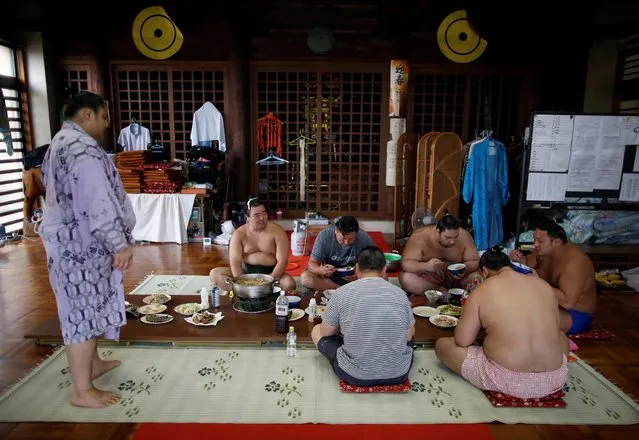
Mongolian-born Tomozuna Oyakata (3rd L), or master of the Tomozuna stable, and his wrestlers eat a meal inside the main hall of Ganjoji Yakushido temple in Nagoya, Japan on July 18, 2017. With rare permission granted by sumo's governing body, Reuters was able to observe the stable's wrestlers training at their temporary Buddhist temple base for the Nagoya Grand Sumo Tournament that kicked off last week, gaining insight into the intricacies of sumo. (Photo by Issei Kato/Reuters)
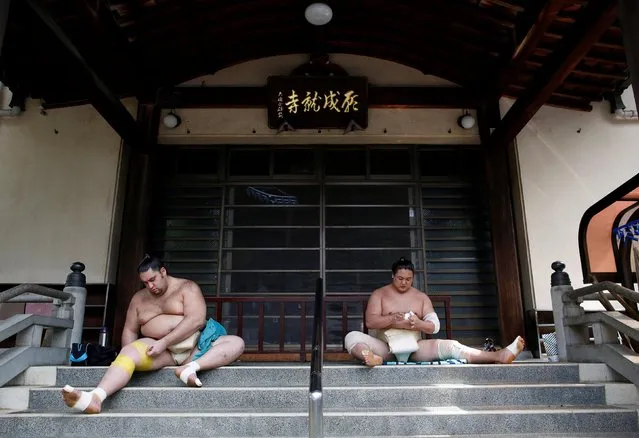
Brazilian-born sumo wrestler Kaisei (L), and Mongolian-born sumo wrestler Kyokushuho tape up during a training session in Nagoya, Japan on July 18, 2017. Entering the world of sumo is to eat, live, and breathe Japanese – from the samurai-style topknots to the rigid hierarchy. (Photo by Issei Kato/Reuters)
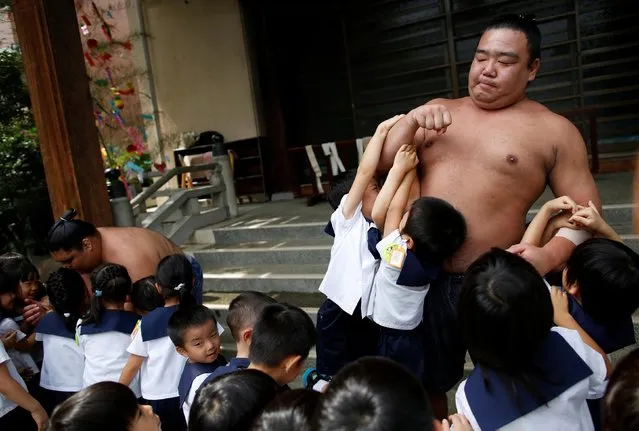
Sumo wrestler Kainoryu (R) plays with kindergarten children at Ganjoji Yakushido temple in Nagoya, Japan on July 18, 2017. (Photo by Issei Kato/Reuters)
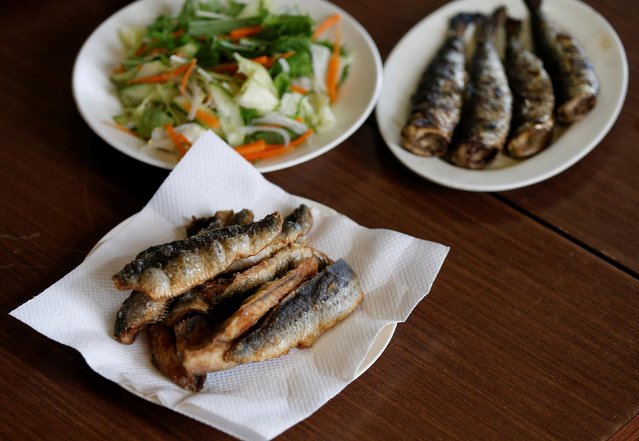
Lunch dishes, some provided by local fans and well-wishers in Nagoya, Japan on July 18, 2017. (Photo by Issei Kato/Reuters)
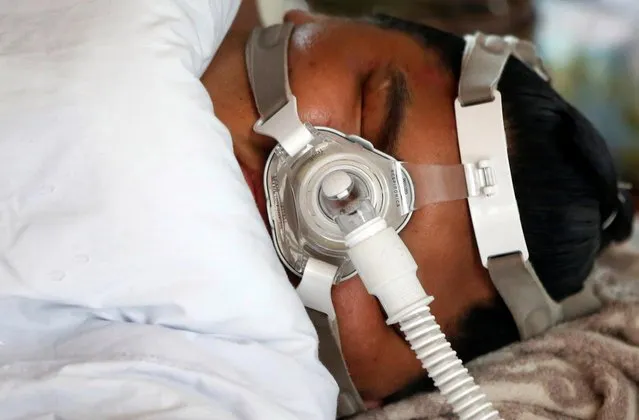
Sumo wrestler Kaiho sleeps using a mask in Nagoya, Japan on July 18, 2017. (Photo by Issei Kato/Reuters)
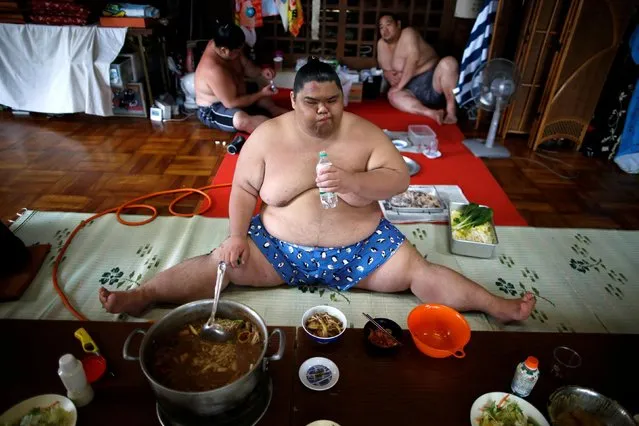
Sumo wrestler Kaiho eats a “chanko” meal in Nagoya, Japan on July 18, 2017. After ending practice at 10:30 a.m., the wrestlers mingle with fans, sign autographs and pose for photos before the first of their two daily meals. (Photo by Issei Kato/Reuters)
20 Jul 2017 07:49:00,
post received
0 comments
